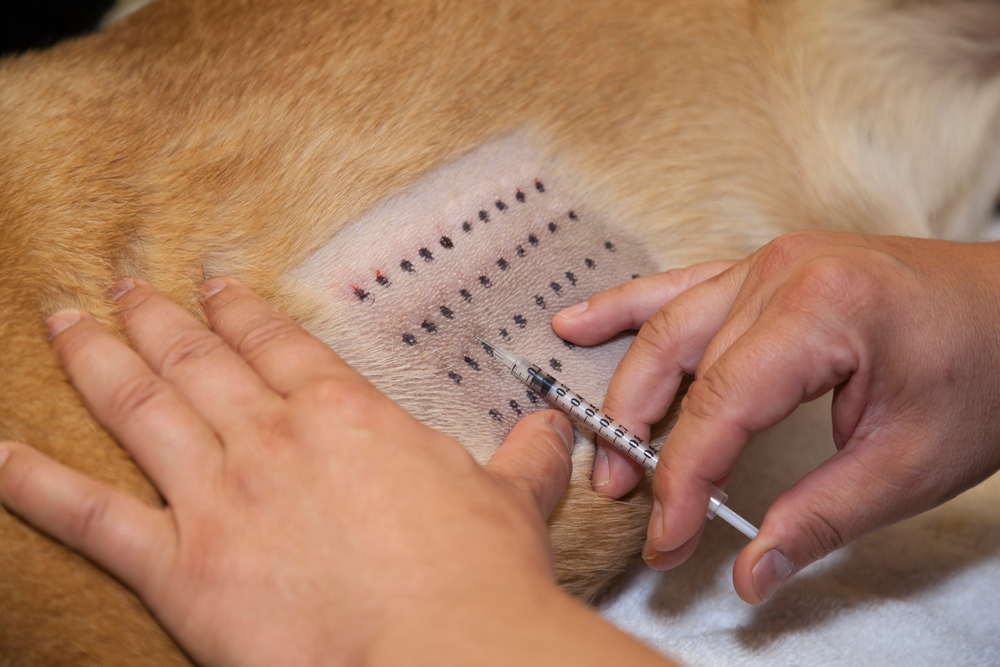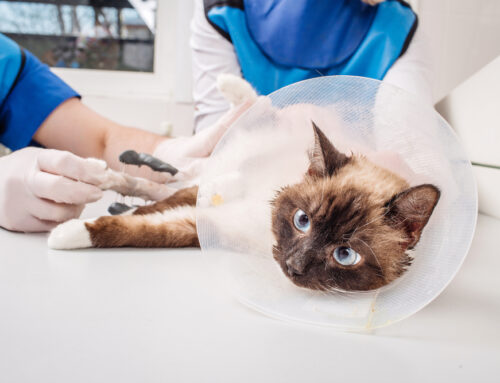Is your pet scratching or chewing at their feet constantly? Severe itchiness is usually a sign that your pet has a serious dermatological condition, and they need veterinary professional care. Our Greenfield Veterinary Clinic team knows the frustrations of an itchy pet, so we offer insights about itchiness causes in pets and how the problem is addressed.
Pet itchiness causes
Pet itchiness can be caused by numerous issues, but the most common culprits include:
- Allergies — Allergies most commonly cause pet itchiness and include:
- Flea allergy dermatitis (FAD) — FAD is an allergic response to the flea’s saliva. A single flea bite can cause itchy skin for up to two weeks.
- Atopy — Atopy is an allergic response to environmental allergens, such as mold spores, dust mites, and grass and tree pollen. Affected pets have a dysfunctional skin barrier that allows the allergens to enter and cause inflammation.
- Food allergies — Pets can develop an allergy to ingredients in their food, most commonly proteins and complex carbohydrates. Common triggers are beef, chicken, dairy, eggs, and wheat.
- Infection — Bacterial and yeast infections can cause pet itchiness. Skin infections commonly occur secondary to allergic dermatitis, and can complicate the diagnosis.
- Mites — Sarcoptic mites burrow under the skin, causing severe pet itchiness.
Pet itchiness diagnosis
The reason behind your pet’s itchiness must be determined to properly treat the problem. Steps include:
- History — Our team takes a thorough medical history and asks questions that may include:
- When did your pet’s itchiness start? — In some cases, your pet’s age when they begin itching can help determine the cause. Atopy typically starts when pets are between 1 and 3 years of age, and food allergies typically start when pets are younger than 6 months or older than 6 years of age.
- Has your pet been itchy before? If so, when? — If your pet’s itchiness occurs only at certain times of the year, they are likely atopic.
- Is your pet on any medications? — Some medications can lead to itchiness.
- Is your pet on year-round flea prevention? — Year-round flea prevention is necessary to control FAD.
- Has your pet’s diet or environment changed? — This helps our team determine if your pet is allergic to their food or a new material or household product.
- Has your pet exhibited any other signs? — If your pet also has gastrointestinal (GI) signs, they may have a food allergy.
- Physical examination — We thoroughly assess your pet, especially noting their lesions’ location, which can, in some cases, help determine the underlying cause. Examples include:
- Flea allergy dermatitis — FAD usually causes hair loss and skin lesions on the pet’s lower back, abdomen, and inner thighs.
- Atopy — Atopy can affect the pet’s entire body, but hair loss and skin lesions most commonly occur around the eyes and mouth, on the paws, groin, armpits, and under the tail.
- Food allergies — Dogs often have hair loss and skin lesions on their face, paws, and around their anus, while cats have signs on their head and neck.
- Mites — Sarcoptic mites usually cause hair loss and skin lesions on the ears, ankles, armpits, and elbows.
- Skin scraping — We will scrape the affected skin to evaluate the cells microscopically, looking for abnormalities, including mites.
- Skin biopsy — In some cases, we may need a biopsy to evaluate the deeper skin layers.
- Culture — If your pet has a skin infection, we perform a culture to determine the causative microorganism.
- Blood work — Our team may perform blood work to assess your pet’s health and rule out certain conditions.
- Allergy testing — If we diagnose atopy, allergy testing is helpful to determine the environmental allergens causing the reaction.
- Hypoallergenic food trial — If we suspect your pet has a food allergy, we will recommend a hypoallergenic food trial to determine the ingredient causing the reaction. This involves feeding the hypoallergenic diet for about eight weeks, during which time your pet must not eat treats, flavored medications or supplements, or table scraps.
Pet itchiness treatment

Addressing pet itchiness usually requires a multimodal approach. Our team will tailor a plan based on your pet’s specific diagnosis and condition, but potential treatments include:
- Flea control — Year-round flea control is important for all itchy pets, and the only way to prevent reactions in FAD pets. Pets affected by other allergic conditions often have FAD. Flea prevention products also kill sarcoptic mites. All pets in your home must be treated.
- Bathing — Bathing helps remove allergens from your pet’s skin, and most pets benefit from a weekly bath. Between baths, use a wet cloth to wipe allergens from your pet’s coat, especially after outings.
- Allergen avoidance — To limit your atopic pet’s allergen exposure, vacuum your home frequently, keep your doors and windows closed, and keep your pet inside when you mow your lawn.
- Steroids — Steroids are often necessary, especially in the acute stages, to alleviate your pet’s itchiness.
- Anti-itch medications — Nonsteroidal anti-itch medications are also useful.
- Antihistamines — Antihistamines aren’t typically as effective for pets as for humans, but they may help when used in conjunction with other medications.
- Omega-3 fatty acids — Many itchy pets benefit from omega-3 fatty acids’ anti-inflammatory properties.
- Antimicrobials — Our team will prescribe an appropriate topical or systemic antimicrobial for your pet’s skin infection.
- Hyposensitization therapy — Allergy shots help desensitize atopic pets to the allergens causing their reaction.
If your pet can’t stop scratching or chewing their feet, contact our Greenfield Veterinary Clinic team as soon as possible. We will identify the underlying cause, create an effective anti-itch strategy, and give your pet some relief.







Leave A Comment